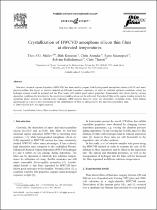JavaScript is disabled for your browser. Some features of this site may not work without it.
- ResearchSpace
- →
- Research Publications/Outputs
- →
- Journal Articles
- →
- View Item
| dc.contributor.author |
Muller, TFG

|
|
| dc.contributor.author |
Knoesen, D

|
|
| dc.contributor.author |
Arendse, C

|
|
| dc.contributor.author |
Swanepoel, R

|
|
| dc.contributor.author |
Halindintwali, S

|
|
| dc.contributor.author |
Theron, C

|
|
| dc.date.accessioned | 2007-08-06T09:00:53Z | |
| dc.date.available | 2007-08-06T09:00:53Z | |
| dc.date.issued | 2006 | |
| dc.identifier.citation | Muller, TFG, et al.2006. Crystallization of HWCVD amorphous silicon thin films at elevated temperatures. Thin Solid Films, Vol. 501, pp 98-101 | en |
| dc.identifier.issn | 0040-6090 | |
| dc.identifier.uri | http://hdl.handle.net/10204/1089 | |
| dc.description | Copyright: 2006 Elsevier Science B.V | en |
| dc.description.abstract | Hot-wire chemical vapour deposition (HWCVD) has been used to prepare both hydrogenated amorphous silicon (a-Si:H) and nano/ microcrystalline thin layers as intrinsic material at different deposition conditions, in order to establish optimum conditions where the hydrogen content would be minimal and the films would still exhibit good optical properties. Experimental data shows that by varying deposition conditions the transition to the nano/microcrystalline phase can be achieved. Transitional films in the regime tending towards the crystalline phase showed no infrared-active hydrogen. XRD analysis failed to show any discernible crystalline peaks, while Raman spectroscopy as a tool is more promising for the identification of films in changeover to the nano/microcrystalline state. | en |
| dc.language.iso | en | en |
| dc.publisher | Elsevier Science B.V. | en |
| dc.subject | HWCVD | en |
| dc.subject | Hot-wire chemical vapour deposition | en |
| dc.subject | Silicon thin films | en |
| dc.subject | Microcrystalline thin layers | en |
| dc.subject | Crystalline | en |
| dc.title | Crystallization of HWCVD amorphous silicon thin films at elevated temperatures | en |
| dc.type | Article | en |
| dc.identifier.apacitation | Muller, T., Knoesen, D., Arendse, C., Swanepoel, R., Halindintwali, S., & Theron, C. (2006). Crystallization of HWCVD amorphous silicon thin films at elevated temperatures. http://hdl.handle.net/10204/1089 | en_ZA |
| dc.identifier.chicagocitation | Muller, TFG, D Knoesen, C Arendse, R Swanepoel, S Halindintwali, and C Theron "Crystallization of HWCVD amorphous silicon thin films at elevated temperatures." (2006) http://hdl.handle.net/10204/1089 | en_ZA |
| dc.identifier.vancouvercitation | Muller T, Knoesen D, Arendse C, Swanepoel R, Halindintwali S, Theron C. Crystallization of HWCVD amorphous silicon thin films at elevated temperatures. 2006; http://hdl.handle.net/10204/1089. | en_ZA |
| dc.identifier.ris | TY - Article AU - Muller, TFG AU - Knoesen, D AU - Arendse, C AU - Swanepoel, R AU - Halindintwali, S AU - Theron, C AB - Hot-wire chemical vapour deposition (HWCVD) has been used to prepare both hydrogenated amorphous silicon (a-Si:H) and nano/ microcrystalline thin layers as intrinsic material at different deposition conditions, in order to establish optimum conditions where the hydrogen content would be minimal and the films would still exhibit good optical properties. Experimental data shows that by varying deposition conditions the transition to the nano/microcrystalline phase can be achieved. Transitional films in the regime tending towards the crystalline phase showed no infrared-active hydrogen. XRD analysis failed to show any discernible crystalline peaks, while Raman spectroscopy as a tool is more promising for the identification of films in changeover to the nano/microcrystalline state. DA - 2006 DB - ResearchSpace DP - CSIR KW - HWCVD KW - Hot-wire chemical vapour deposition KW - Silicon thin films KW - Microcrystalline thin layers KW - Crystalline LK - https://researchspace.csir.co.za PY - 2006 SM - 0040-6090 T1 - Crystallization of HWCVD amorphous silicon thin films at elevated temperatures TI - Crystallization of HWCVD amorphous silicon thin films at elevated temperatures UR - http://hdl.handle.net/10204/1089 ER - | en_ZA |






